Paddle into the wild heart of the Everglades!
This vast subtropical wilderness invites exploration by kayak, canoe, and paddle as you wind through lush mangrove tunnels, slip across mirror-still lakes, and bask in sunny bayous.
Seek adventure along 99 winding miles of the Wilderness Waterway or take a peaceful day trip down the Turner River.
Spy alligators, turtles, and exotic birds at every turn. Camp under a blanket of stars on remote beaches and wooded islands.
From choosing the perfect launch site to planning a route that matches your skill level, this comprehensive guide will equip you with the knowledge to plan your journey.
Embark on a trip unlike any other through the swamps and streams of this treasured River of Grass. Adventure awaits — keep paddling!
Getting Started
If you're planning a trip to paddle, kayak, or canoe through Everglades National Park, you should know a few things to make the most of your experience.
This section will cover some tips for planning your trip and getting started.
Planning Your Trip
Before you hit the water, you should plan your trip carefully. Here are a few things to consider:
1. Where to Launch
The park has several launch points, including the Flamingo Visitor Center, Gulf Coast Visitor Center, and Everglades City — all covered later in this article.
You can also rent equipment from local livery services.
2. What to Bring
Be sure to pack plenty of water, sunscreen, and insect repellent. You may also want to bring a hat, sunglasses, and a dry bag to keep your belongings safe.
3. Recommended Routes
The park offers a variety of paddling trails, ranging from beginner to advanced.
Some popular routes include the Sandfly Island Loop, Turner River, and Flamingo Paddling Trails. Keep reading to learn about these best routes!
4. Wildlife
Watch for manatees and bird species while you're on the water. Remember to give wildlife plenty of space and never feed them.
Choosing Your Vessel
You want to select a craft that is stable, easy to maneuver, and suited to the type of water you'll be paddling. Here are some options to consider:
Kayaks
Kayaks are a popular choice for exploring the park's waterways. They are lightweight, easy to maneuver, and can navigate through narrow channels and shallow waters.
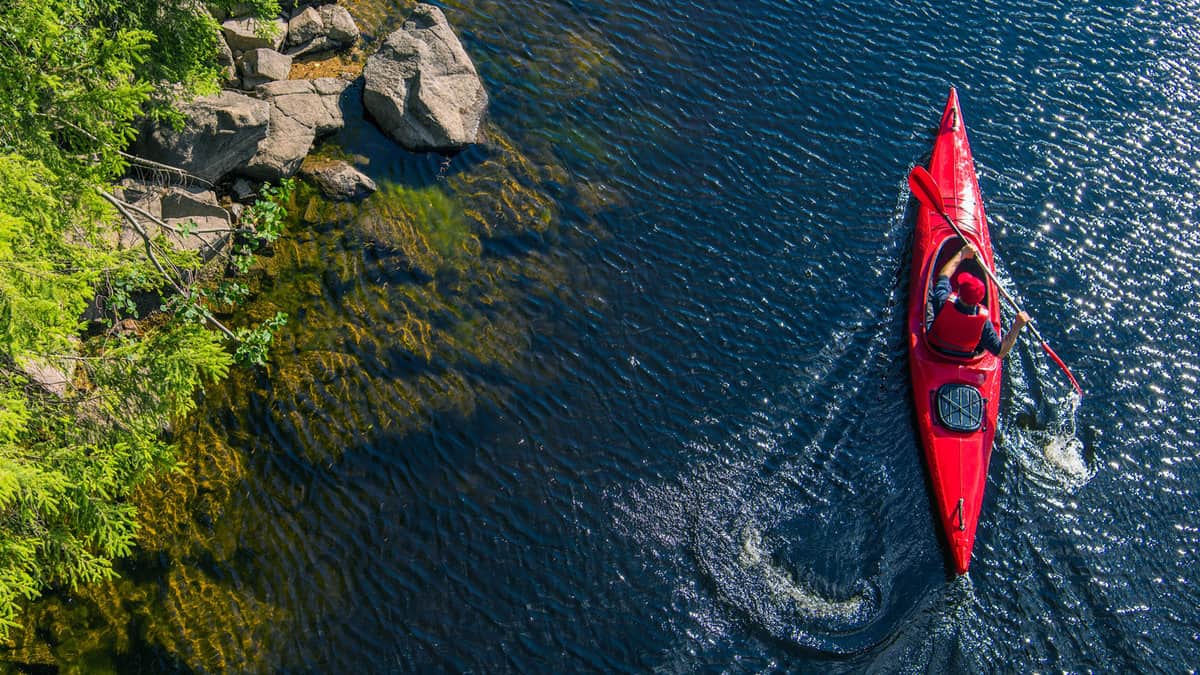
Kayaks come in various shapes and sizes, from sit-on-top models that are great for beginners to sleek touring kayaks that are perfect for longer trips.
Canoes
Canoes are another excellent option for exploring Everglades National Park.
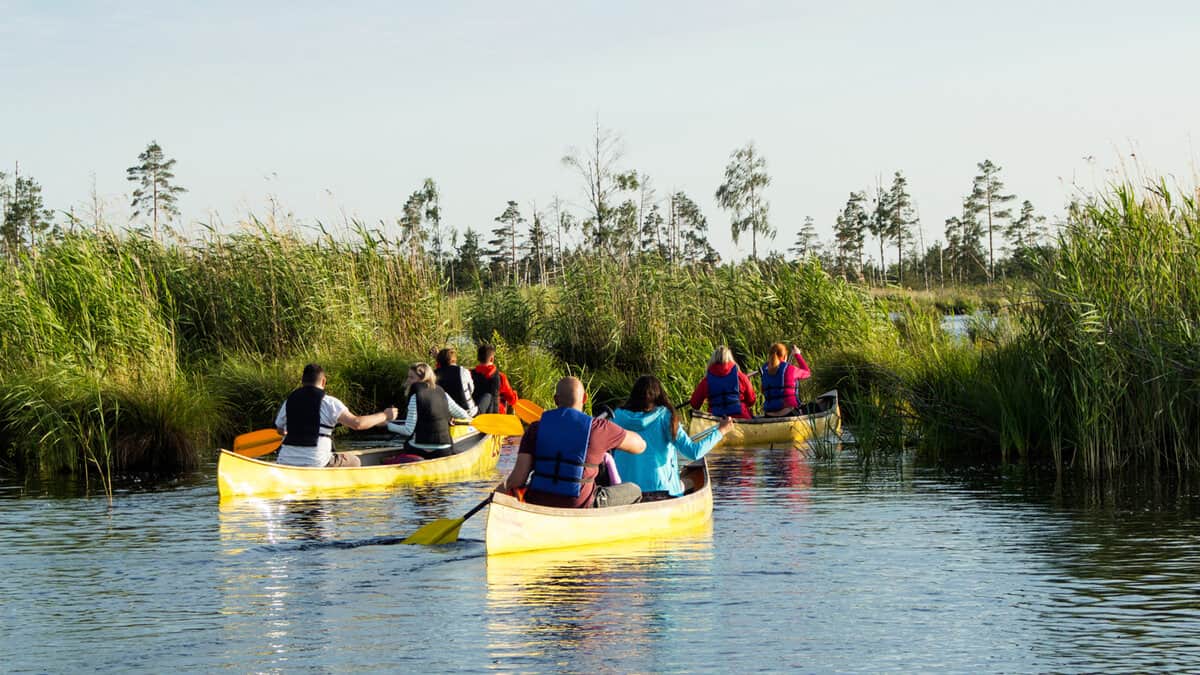
They are stable and usually accommodate two or more people, making them ideal for family outings or group trips.
Canoes also carry gear and supplies, making them popular for multi-day expeditions.
Small Boats
Small boats like jon boats and skiffs are great for those who prefer a more leisurely pace.
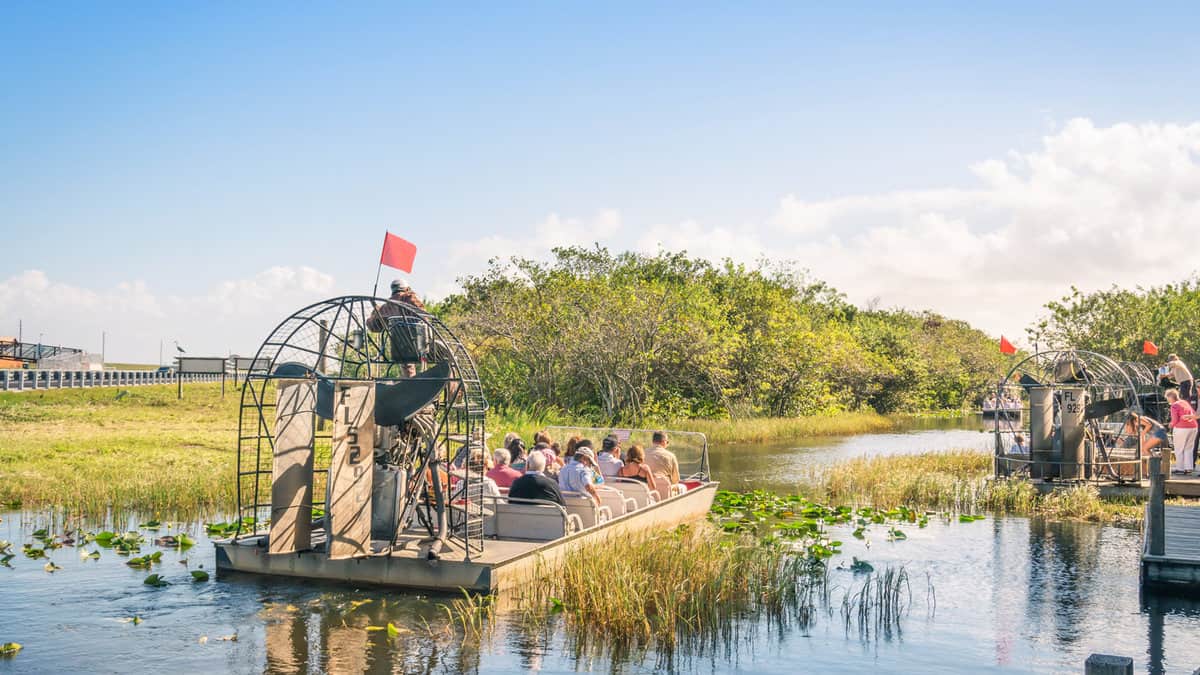
These vessels are stable and can navigate through shallow waters, making them perfect for exploring the park's mangrove tunnels and other narrow waterways.
They are also ideal for fishing and wildlife viewing.
Take Your Pick: 12 Must-Do Activities at Everglades National Park
1. Paddle through Mangrove Tunnels
Paddling through lush mangrove tunnels is a quintessential Everglades experience.
Head to the Flamingo area and launch into Buttonwood Canal, leading to Coot Bay for stunning scenery. The mangrove tunnels here are simply breathtaking.
2. Bicycling
Explore the park's scenic trails on a bicycle. Some recommended areas for bicycling include Shark Valley, the Snake Bight Trail near Flamingo, and the Long Pine Key Nature Trail.
3. Bird Watching
Observe the diverse bird species that inhabit the Everglades. Keep an eye out for great blue herons and roseate spoonbills, among others.
4. Boating
Experience the park's unique ecosystem by exploring its waterways.
Whether you own a boat, rent one, or join a tour from Flamingo or the Gulf Coast, boating offers an opportunity to get closer to the park's wildlife.
5. Camping
Spend a night under the stars at one of the park's campgrounds.
Long Pine Key and Flamingo campgrounds provide drinking water, picnic tables, showers, grills, restrooms, and tent and trailer sites.
6. Kayaking & Canoeing
Glide through the water in a kayak or canoe and immerse yourself in the beauty of the Everglades.
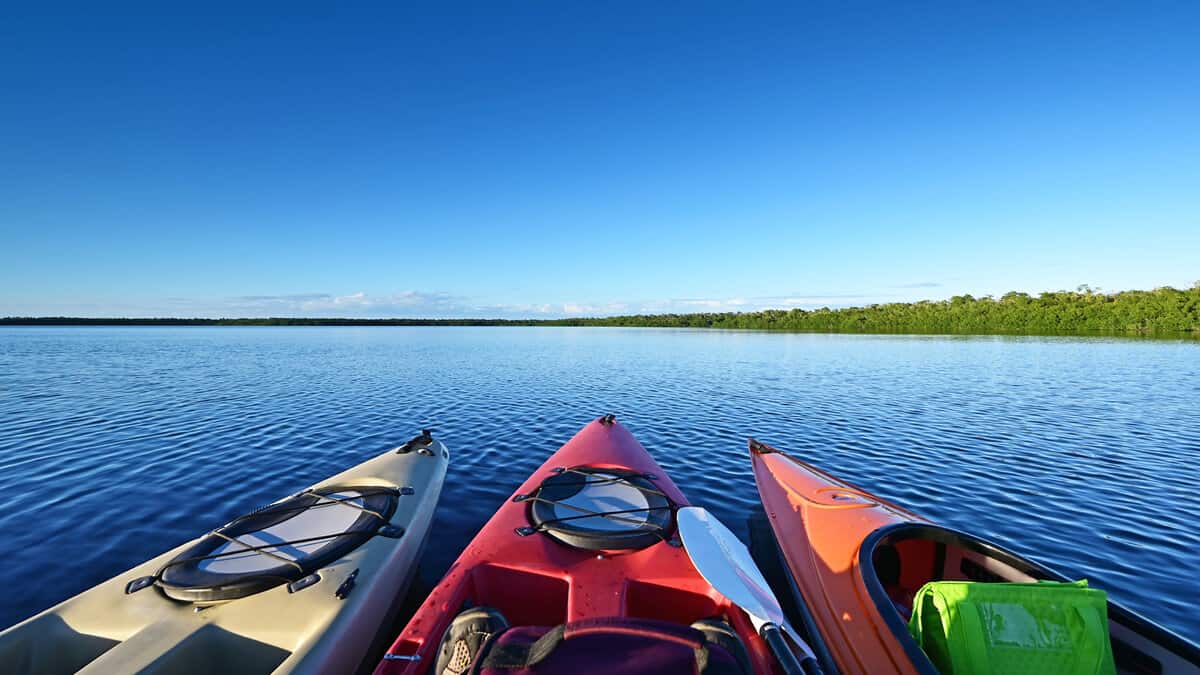
The Wilderness Waterway is a popular route for longer trips, but shorter trails are also available.
7. Fishing
Enjoy saltwater and freshwater fishing in designated areas of the park. Check with a visitor center for fishing regulations and the closed regions.
8. Geocaching
Embark on a real-world treasure hunt by participating in geocaching. Use GPS-enabled devices to locate hidden containers called geocaches and share your experiences online.
9. Hiking
Explore the park's trails on foot and discover its diverse flora and fauna. In addition to short interpretive trails, there are longer hiking trails available.
10. Ranger-Led Programs
Enhance your knowledge of the park by participating in ranger-led activities such as hikes, canoe trips, bicycle trips, tram tours, and campfire programs.
11. Slough Slogging
For a unique hiking experience, try slough slogging. This off-trail hiking lets you get closer to some of the park's more elusive species.
12. Tours
Enjoy guided tours through the park offered by concession boat captains, Tram Tour naturalists, and Everglades National Park Institute naturalists.
Navigating the Everglades
Next up — here are the basics of navigating the park's waterways and tips for getting the most out of your trip!
Waterways and Trails
Check out some of the most popular routes:
| Trail Name | Distance | Description |
|---|---|---|
| Everglades Paddling Trail | 120 miles | This trail provides wilderness and backcountry opportunities and includes several segments with boating use restrictions to enhance visitor enjoyment in the busy winter-spring seasons. |
| Hell's Bay Canoe Trail | 6.75 miles | This trail takes you through a maze of mangrove islands and shallow bays, providing opportunities for birdwatching and fishing. |
| West Lake Kayak Trail | 7.7 miles | This trail takes you through interconnected lakes and channels, offering views of birds, alligators, and other wildlife. |
| Wilderness Waterway | 99 miles | This trail is the ultimate backcountry adventure, taking you through the heart of the park's wilderness. It requires advanced planning and navigation skills. |
Launching Points
There are several launching points throughout the park, each offering access to different waterways and trails. Here are some of the most popular launching points:
| Launching Point | Waterway Access | Amenities |
|---|---|---|
| Flamingo | Hell's Bay Canoe Trail, Wilderness Waterway | Rentals, restrooms, camping, food, and drink |
| Gulf Coast | Wilderness Waterway | Camping, restrooms, and fishing |
| Nine Mile Pond | Nine Mile Pond Kayak Trail | Rentals, restrooms, and picnic area |
| Long Pine Key | West Lake Kayak Trail | Campground, restrooms, and picnic area |
Remember that some trails restrict motorized boats, so check the park's website for the latest information before planning your trip.
Exploring Key Locations
Here are some of the top spots to check out:
Flamingo
Flamingo is a popular destination for paddlers at the park's southern end.
The Flamingo Marina is a great place to launch your small watercraft, and there are several trails to explore, including the 1.6-mile Snake Bight Trail and the 6.75-mile Hell's Bay Canoe Trail.
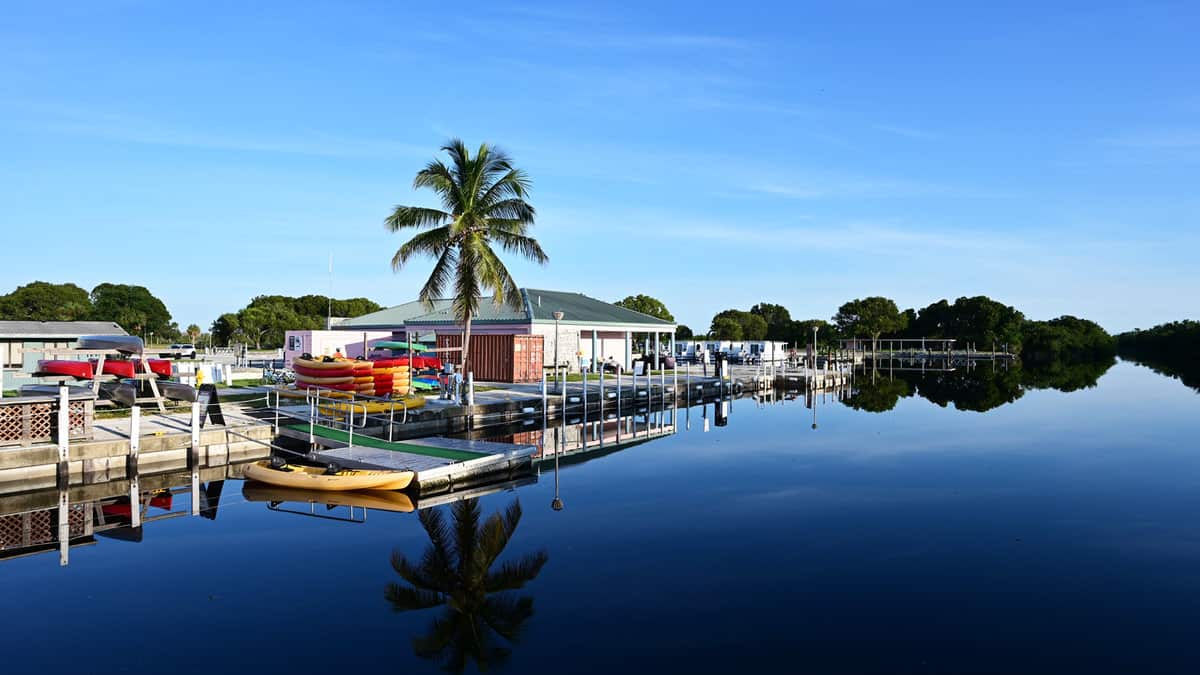
The Flamingo Visitor Center is also a must-visit, offering information about the park's history, ecology, and wildlife.
Everglades City
Everglades City is a great place to start if you want a more remote and wild experience. This small town is located on the park's western edge, offering access to the Ten Thousand Islands area.
You can explore the mangrove estuaries and tidal creeks from here and spot some dolphins, manatees, or sea turtles.
Cape Sable
For a truly rugged and isolated experience, head to Cape Sable at the park's southern tip.
This area is only accessible by boat, offering some of the park's best fishing and birdwatching opportunities. If you're up for a challenge, consider paddling the 15-mile route from Flamingo to Cape Sable.
Ten Thousand Islands
The Ten Thousand Islands area is one of the park's most popular paddling spots.
Explore this maze of mangrove islands and waterways to encounter a wide variety of wildlife like alligators, herons, and ospreys.
The area has several launch points, including the Gulf Coast Visitor Center.
Wildlife and Scenery
Here are some highlights to look out for during your paddle, kayak, or canoe adventure:
Bird Watching
Everglades National Park is a birdwatcher's paradise, with over 300 species of birds calling the park home. Look for herons, egrets, ibises, and roseate spoonbills wading in the shallow waters or perched on tree branches.
You may also spot ospreys and bald eagles soaring overhead or hear the distinctive call of the great horned owl at night.
Alligator Spotting
One of the most iconic animals in the park is the American alligator. These prehistoric-looking creatures can be seen sunning themselves on the banks of the rivers or swimming in the water.
Keep a safe distance and never approach or feed them. Remember, they are wild animals and should be respected.
Mangrove Tunnels
Paddling through the mangrove tunnels is a must-do activity at Everglades National Park.
These winding waterways are lined with dense mangrove forests, creating a unique and beautiful ecosystem home to various wildlife.
The best areas for mangrove tunnel paddling include the Turner River, Hell's Bay, and the East River. As you paddle through the tunnels, you'll be surrounded by towering mangrove trees and may spot crabs scuttling along the roots.
Watch for fish jumping out of the water or the occasional manatee or dolphin swimming by.
Camping and Amenities
When planning your paddling, kayaking, or canoeing trip to Everglades National Park, it's essential to consider where you'll be camping and what amenities are available.
Here are some key things to know:
Camping Spots
Several wilderness campsites are available throughout the park, but a permit is required for all of them.
You can obtain a permit the day before or the day of your trip at the Flamingo or Gulf Coast Visitor Centers.
Keep in mind that most wilderness campsites are only accessible by water. Use the Wilderness Trip Planner to help plan your trip.
Picnic Areas
Several picnic areas are located throughout the park, including Flamingo and Gulf Coast. These areas are great for taking a break from paddling and enjoying a meal.
Remember that these areas can get busy, especially during peak season, so plan accordingly.
Toilet Facilities
Toilet facilities are available at various locations throughout the park, including at Flamingo and Gulf Coast.
However, remember that some wilderness campsites do not have toilet facilities, so plan accordingly and bring your supplies.
Safety and Considerations
Here are some tips to help ensure a safe and enjoyable trip:
1. Check water levels.
Before heading out, check the water levels in the area you plan to explore.
High water can create solid currents and make paddling more difficult, while low water can expose rocks and other hazards.
Check water levels on the National Park Service website or call the visitor center.
2. Rent from a reputable outfitter.
If you don't have equipment, consider renting from a reputable outfitter. They can provide the right gear for the conditions and ensure everything works well.
Some outfitters also offer guided tours, a great way to explore the park with an experienced guide.
3. Wear a life jacket.
Always wear a properly fitting life jacket when paddling.
Even if you're a strong swimmer, unexpected accidents can happen, and a life jacket can help keep you afloat.
4. Be aware of wildlife.
While these wildlife in the Everglades are rarely aggressive towards humans, keeping a safe distance and avoiding disturbing them is essential.
If you're traveling with a pet, keep them on a leash and away from wildlife.
Start Your Everglades Adventure Today!
Paddling through the magical mangrove tunnels, sawgrass prairies, and winding rivers of Everglades National Park is a bucket-list experience for outdoor enthusiasts everywhere.
With excellent year-round weather and trails for every skill level, the time to plan your small watercraft adventure is now.
Study park maps and reserve campsites early, and book a rental kayak or canoe for your dates. The friendly park rangers can help with trip planning and waterway conditions before you launch.
As you explore this vast and unique ecosystem, respect wildlife, take lots of pictures, and revel in the simplicity of traveling by paddle power.
See you on the water!
For more Florida park adventures, check out:
Top 3 RV Parks Near St. Augustine, Florida
7 Best RV Parks in Key West, Florida
4 Best RV Parks Near Sanibel Island: Where To Park & Play!
